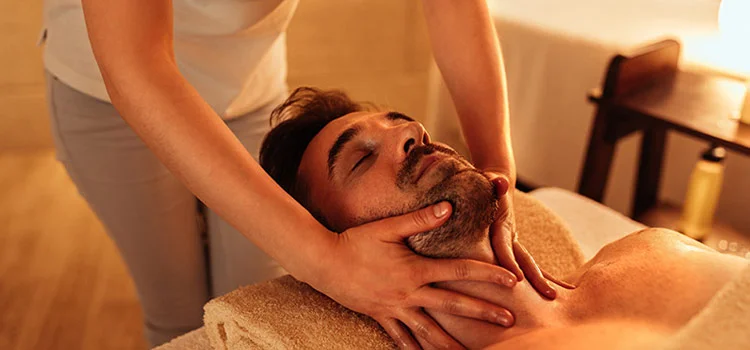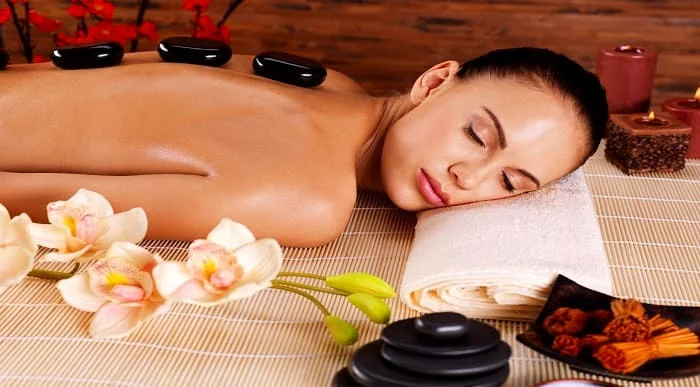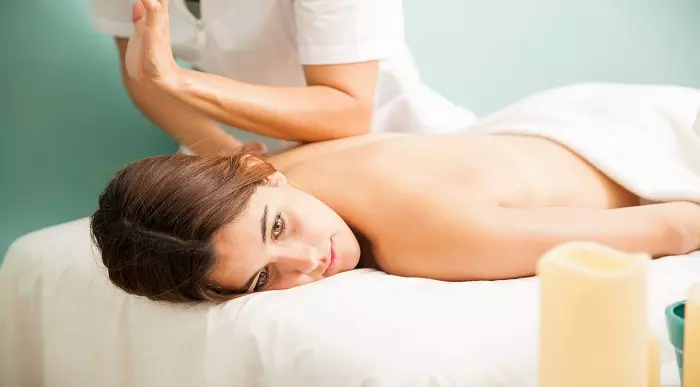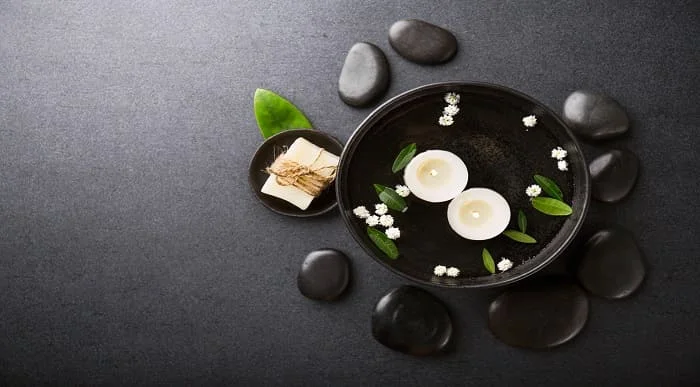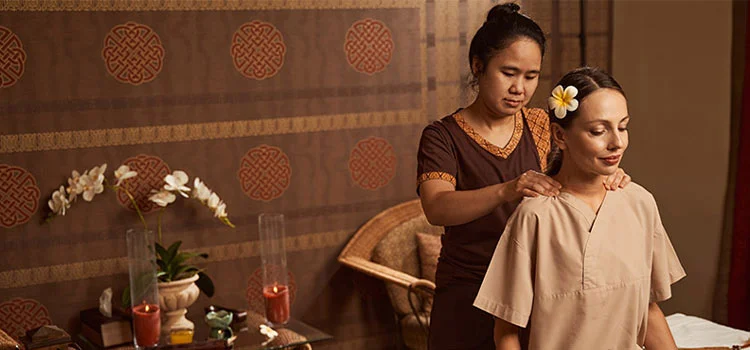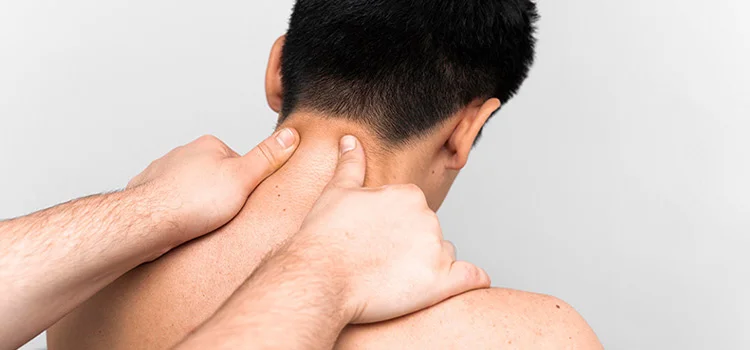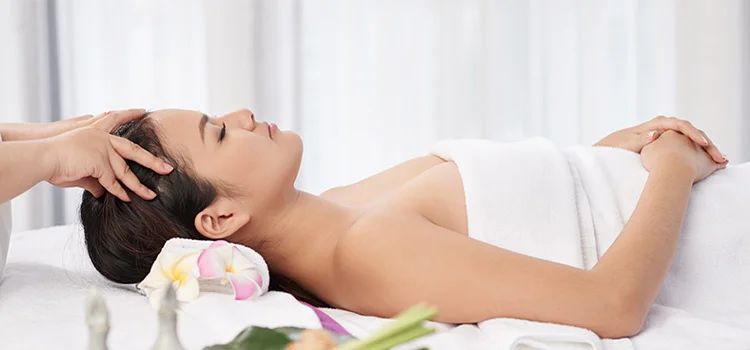Make Up & Beauty
Indian Head Massage A to Z – Step by Guide Include
Indian head massage is a relaxing holistic treatment that massages acupressure points on the head, face, neck and shoulders with the aim of rebalancing your body’s energies. The main purpose of an Indian head massage is to free the channels of negative energy that are believed to be the origin of indispositions.
Massage has been most commonly used in Asian countries but is now widely practised as a complementary therapy in the west as well. This blog provides the details of Indian head massage A-Z. Along with head massage techniques, you will see their benefits, and the procedure and video guides. Do give it a read!
Table of Content
- What is an Indian Head Massage?
- The History of Indian Head Massage
- What does Indian Head Massage Involve?
- What are the Various Techniques Used in the Indian Head Massage?
- Which equipment do you need for Indian Head Massage?
- What are the Benefits of Indian Head Massage?
- How is the Indian Head Massage Performed?
- Frequently Asked Questions
- What you should Avoid doing before an Indian Head Massage?
- What you should Avoid doing before an Indian Head Massage?
- Who should not have an Indian Head Massage?
- Does Indian Head Massage Cause Hair Loss?
- Can it help with Headaches?
- Are Oils used during an Indian Head Massage?
- Are there any Side Effects of the Indian Head Massage?
- How often should I have an Indian Head Massage?
- Are Indian Head Massages Safe?
- Can I do the Massage Myself?
- How much does it Cost?
- Conclusion
- What to Read Next:
What is an Indian Head Massage?
Indian Head Massage is an ancient therapy treatment, based on the ayurvedic system of healing. The massage technique originated in India approximately 1,000 years ago and was introduced in western culture during 1970’s. In addition, it is a deep massage that uses a variety of pressure and techniques, including circular massage strokes on your scalp, deep tissue work on your shoulders, and stretching of the neck.
The Indian head massage primarily focuses on relieving the tension of your head, neck and shoulder area. It was originally introduced to improve scalp and hair conditions. However, it can also help with relieving fatigue, insomnia, headaches, and sinusitis.
The History of Indian Head Massage
The Indian head massage or ‘Champissage’ is based on Ayurveda-an ancient, a holistic healthcare system that focuses on the importance of achieving balance among mind, body and spirit to promote and maintain good health, wellbeing and longevity.
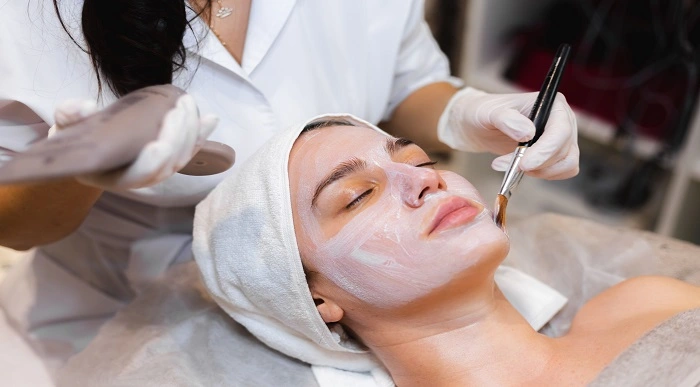
Luxury Spa Facial Course
- Accredited Courses
- Tutor Support Included
- 3 Installment Plan at checkout
- 14 Days Money Back Guarantee
Indian head massage was first documented in the texts of Ayurveda around 600 BC. The text proposed that each individual is made up of five elements—earth, air, fire, water and ether along with the three life-giving forces, which are vata, pitta and kapha. According to the ayurvedic teachings, being healthy means having your forces in harmony and massage helps achieve that goal.
The massage was traditionally practised in the family setting in India. The Indian women gave regular head and scalp massages to their children and other family members back then. Since then, this tradition has been kept alive and passed down from generation to generation.
It became a popular complementary therapy in the West after Narendra Mehta came to Britain to train in physiotherapy and was disappointed when massages he had did not include the head. In 1981, he set up a stall in the Mind, Body and Spirit exhibition at London Olympia to show and let people know about the massage. People with great enthusiasm received the therapy and thus, modern Indian head massage was born.
What does Indian Head Massage Involve?
A complete Indian head massage session usually lasts for 30-45 minutes. Before the therapy, your therapist might inquire about your lifestyle, any particular aches, pains or ailments you have. You might also be asked about any medical treatments or medicines you are taking since the therapist needs to be careful about the oils, pressures and techniques.
During the treatment, the client can either remain fully clothed and sit in a massage chair or undress the upper half of the body and lie down on a massage couch. The massage usually begins with the shoulders and upper back, then gradually moves onto the arms and finally the head, scalp and face.
The massage therapist uses a range of movements, including kneading, stroking, and compression over the neck, shoulder, and scalp. As the treatment progresses, the client’s breathing slows, the mind quietens and by the end of the session, they are filled with an overall sense of peace.
What are the Various Techniques Used in the Indian Head Massage?
The various techniques used to perform the Indian head massage are-
- Effleurage (soothing and stroking movements)
- Petrissage (kneading and squeezing)
- Tapotement (hacking and tapping)
- Friction (rubbing and ‘shampooing’)
- Feathering (light finger pressure)
- Stretching (of the neck)
- Rotation (of the shoulder joint)
Which equipment do you need for Indian Head Massage?
The Indian head massage does not require any equipment as it is typically done with hands. Some prefer using a tingle massager, but that is not used in the traditional method.
The Use of Oils in Indian Head Massage
Though oil is optional during the treatment, oils are often selected depending on their therapeutic value and healing qualities as per the tradition.
Oils used during the massage are blended to enhance relaxation, health and well-being. Oil is a nutrient for both the skin and hair that prevents dryness. Further, oil is absorbed through the hair follicles which helps stimulate the scalp, slowing the loss of hair and premature greying. In a traditional Indian head massage, oil has a medicinal purpose; different oils are used for different constitutions, genders and personality types.
The most commonly used oils are sesame, coconut and mustard oil. Sesame oil is a popular choice. It is astringent and sweet. It contains essential amino acids that are beneficial for brain functioning.
Coconut oil is sweet, cooling and light. This one is a women’s favourite as it makes their hair healthy and shiny. Coconut oil is also beneficial for skin rashes, eczema and heat.
Mustard oil is the most pungent and is more popular with men. It is sharp, bitter and heating. Prolonged use of mustard oil can prevent hair loss. The oils are most effective if left overnight or for a few days.
What are the Benefits of Indian Head Massage?
Indian head massage has many physical and psychological benefits. This form of massage focuses on the three higher “chakras”, which are mind, body and spirit and hits your energy epicentre.
As stated in BBC, “according to practitioners, the treatment relieves tension, headaches and also stimulates lymphatic drainage, helping to remove toxins and boost the immune system, as well as restoring joint mobility and improving circulation.”
Some of the further benefits of Indian head massage are-
Relieves migraines, headaches and back pain
Tension in the upper back, neck and head can lead to migraines, headaches and back pain. The massage focuses on applying pressure to points in the upper back, arms and shoulders to reduce tension in the muscles and knots. Massages around the neck and head reduce headache-causing blockages and encourage better circulation of the cerebral fluid.
On-Demand Accredited Courses
Develop your professional skills with our free courses. Lead Academy is a leading provider of online training, learning, connecting millions of students to the skills they need to succeed.
Stimulates lymphatic drainage
The lymphatic system removes waste products from the tissues and Indian head massage aids in this process by stimulating circulation, encouraging the natural drainage of the lymph. It also helps in bringing new nutrients and oxygen to cells.
Helps to sleep better
Indian head massage helps to relieve stress and tension within the body by promoting relaxation, which in turn affects your sleep cycle and allows you to sleep better.
Promotes hair growth
Each hair follicle needs an equal amount of nutrients for the proper growth of each of the strands. Massage to the scalp and head increases nourishment and oxygen to the hair follicle, stimulating hair growth.
Reduces anxiety and depression
Massaging the head encourages the supply of oxygen to the brain, which is one of the best ways to reduce anxiety and depression.
Renews energy levels
The Indian head massage works with the Ayurvedic concept that emphasises on balance. Working on the chakras through this massage technique has a powerful effect in bringing the energy of the body back into balance.
How is the Indian Head Massage Performed?
The Indian head massage follows a systematic process to provide the clients with the utmost pleasure and relaxation.
Know in detail how the entire process is carried out.
Before the Session (Preparations)
The massage requires a quiet place away from any distractions and noise. Before the therapy session, the therapist needs to make sure the room is at a comfortable temperature. There might be some soft music and candles to create a calm and peaceful environment.
The client then takes a seat and gets comfortable. The therapist explains what he will be doing and asks the client to notify of any discomfort or pain.
Massage Therapy Session
- At the beginning of the session, the therapist stands behind the client, placing his hands lightly on the client’s shoulders as they both take several deep breaths.
- The massage begins easing fatigue and tension with an upper back, shoulders, arms, and neck massage. Further, starting close to the neck, the trapezius muscle (at the base of the neck) is squeezed gently. The therapist gradually moves his hands outward to the shoulder. This process is repeated three times, increasing pressure with each pass.
- Next, the therapist brings the hands back up next to the neck with the thumbs extended and makes small circles with the thumbs on either side of the backbone just below the collar line.
- The therapist places the forearms at the sides of the neck and rolls them outwards toward the shoulder. After rotating, the forearms are lifted and moved a couple of inches away from the neck and repeated. When the shoulder is reached, the therapist comes back to the centre and repeats this process two more times.
Massaging the Neck
- While massaging the neck, therapists place one hand at the base of the recipient’s neck and the other hand gently on the client’s forehead to keep their head from falling forward. With the rear hand, the thumb is opened and the hand is glided up the back of the neck.
- Once they reach the hairline, the rear hand is lowered and the process is repeated from the base of the neck. In addition, the client can tilt the head forward without strain or effort while the therapist keeps the hand at the recipient’s hairline.
- The head is gently lifted back to a vertical position and further backward without forcing, simply allowing the head to move within its own range of motion. The process is repeated 3 times, forward and backwards.
Indian Head Massage – Neck Massage Tutorial
Massaging the Head
- The client’s hair is made loose as if it is restrained. The therapist brings his hands, with fingers spread, to the sides of the head. With light pressure, the hands are moved up slowly with a shampooing-like motion, trying to keep the heel of the hands in contact with the scalp as well as the fingers.
- Once the top of the head is reached, the fingers are allowed to rise off while maintaining gentle traction from the heels of the hands. The therapist then lowers his hands and moves them around to a different head area. Further, this is repeated four to five times, covering the entire scalp.
Indian Head Massage [Unintentional ASMR] – Relaxing Scalp Massage Tutorial
- Therapists begin rubbing the scalp by moving the rear hand vigorously back and forth. The rubbing is further continued all over the scalp with just the fingertips of both hands.
- With smooth strokes beginning at the forehead, therapists slowly work their way to the back of the head to finish up the therapy. This is done for about a minute, allowing the pressure to become lighter towards the end until finally, their hands float off the head.
The following video can help you with understanding the process of the Indian head massage in detail.
Indian Head Massage with Ayurvedic Oils – Head, Neck & Shoulder Massage for Relaxation
Frequently Asked Questions
What you should Avoid doing before an Indian Head Massage?
Always try to ensure that you do not have a heavy meal before your treatment and always make sure that you avoid alcohol for at least five hours before the treatment.
What you should Avoid doing before an Indian Head Massage?
Always try to ensure that you do not have a heavy meal before your treatment and always make sure that you avoid alcohol for at least five hours before the treatment.
Who should not have an Indian Head Massage?
Indian head massage is a safe and effective treatment, however, it should be avoided by someone who has gone through a recent head, neck, or back surgery or if they have a history of thrombosis, embolism, or spondylitis. The massage should also be avoided by pregnant women and those with broken skin or sores on their scalp, as this may affect the oil and treatment they receive.
Does Indian Head Massage Cause Hair Loss?
In short, the answer is no. The Indian head massage is never a reason for hair loss; rather, it promotes hair growth. It is normal to lose 100 hairs a day, however, if you notice a sudden increase in your hair loss, it might be due to other medical conditions and not for the massage.
Can it help with Headaches?
The Indian Head Massage is an effective treatment for headache sufferers. Further, the combination of brisk friction movements of the massage aids in stimulating and refreshing your head; circular petrissage movements soothe and relieve neck and scalp tension.
With regular therapy, the intensity of stress-related headaches can reduce significantly, as the massage releases tension and promotes relaxation.
Are Oils used during an Indian Head Massage?
It is not necessary to use any oil for Indian Head Massage, but you can ask your therapist to do so if you want. Using oil can help strengthen your hair, promote hair growth, and remove dryness.
Are there any Side Effects of the Indian Head Massage?
The massage has no long-term side effects; however, following a treatment, some clients may experience tiredness, lightheadedness, or aching muscles. All of these can last for more than a few hours at max, after which clients generally experience increased energy and alertness.
How often should I have an Indian Head Massage?
This would depend on why you are having an Indian head massage. If your purpose is to relax and pamper yourself occasionally, you might get the treatment once every two weeks. However, if you are suffering from headaches, migraines, anxiety or depression, you can have more frequent treatments.
Are Indian Head Massages Safe?
The Indian Head Massage is a simple and safe treatment. However, those who are pregnant and had any recent head, neck, and shoulder injuries should avoid the treatment or consult the therapist prior to it.
Can I do the Massage Myself?
Yes, you can do the massage yourself at home. Try to find a calm place in your home where you can massage and relax. You can check this tutorial to know how to perform the massage by yourself.
How much does it Cost?
The price range can vary depending on the factors like location. You prefer to take the treatment; whether you would like a therapist to come to your place or whether you prefer going to a clinic or boutique. Depending on your preferences, you might be able to book a 30-minute treatment starting from as low as £25.
Conclusion
The Indian head massage can relax you, make you feel detached and serene, and alleviate brain fog and stress. If you are having a rough day and want to de-stress yourself, take Indian massage therapy. And, if you are not a client but rather a masseur, hopefully, you can learn the techniques of Indian massage therapy from this blog.
What to Read Next:
- How to Become a Permanent Makeup Artist
- How to Become a Nail Technician
- How Long Does a Lash Lift Take
- The Effects and Disadvantages of Indian Head Massage
- How to Compliment a Makeup Artist?
- Benefits of Indian Head Massage – Physical and Psychological Benefits
- Learn How to Apply Classic Eyelash Extensions



